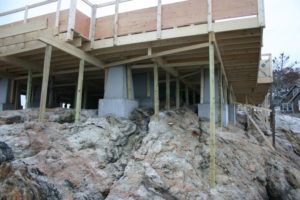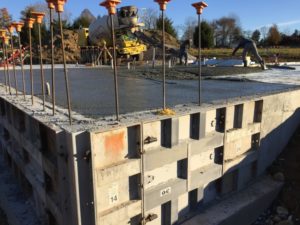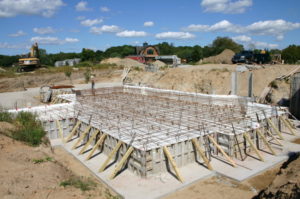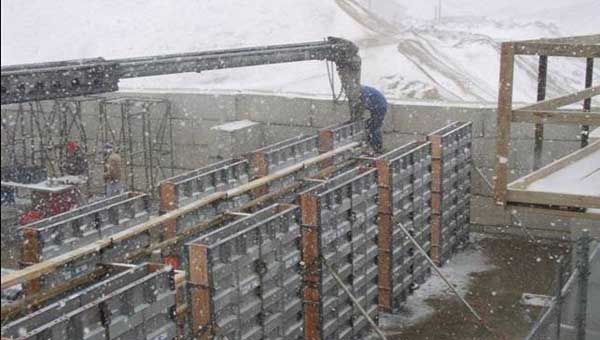For Sale: 1994 Western Star Boom Truck
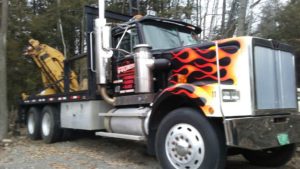
We’re looking to sell our 1994 Western Star Boom Truck. The model is a 4964F with a 60-series, Detroit 12.7 liter 460 hp and an 8LL transmission. Chassis has a 3-stage jake brake and is rated for 12000 lb front, 22560 lb rear with a 57000 lb gvw. The truck also has an air ride cab and suspension. 17’x8′ flat deck bed with center divider. Will fit 13-2′ cages, approx. 44′ of boom reach and will pick 2200 lbs. Comes with remote.
Truck has been well maintained and is ready to go to work. For more information, contact Joe at CFA Member, Hutch Brothers Concrete Corp. 802.479.3499.
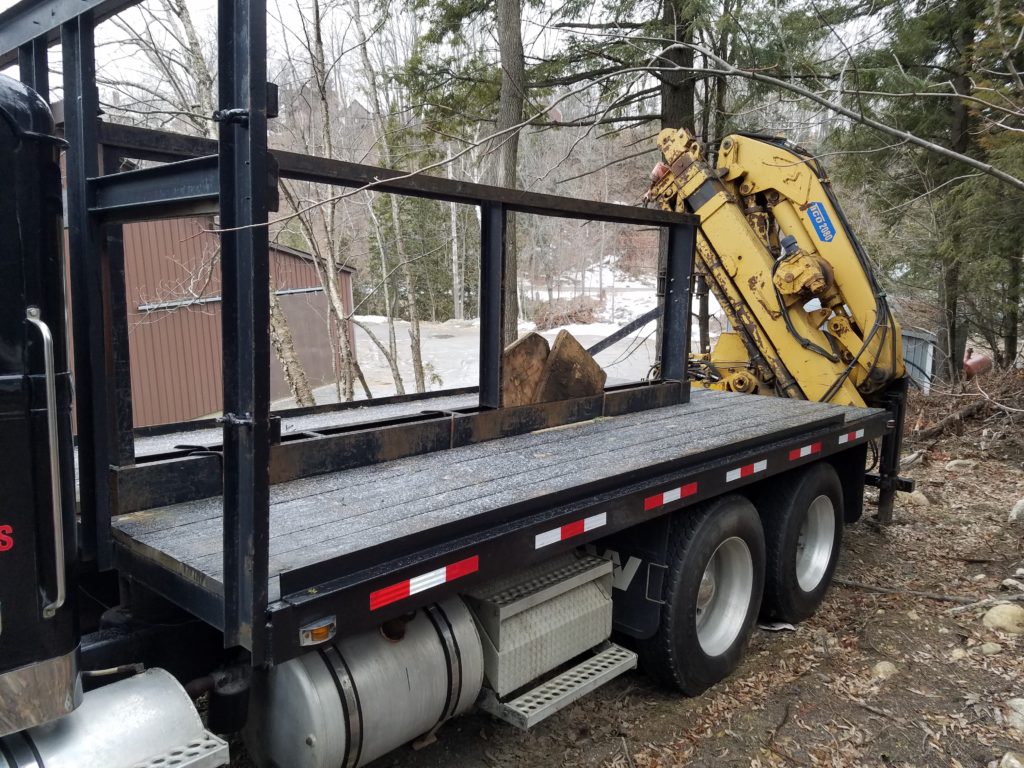
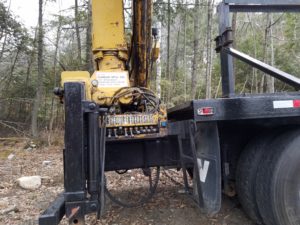
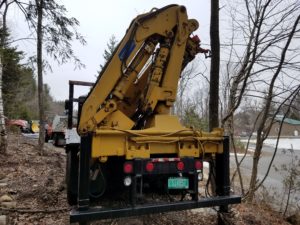

PURINTON BUILDERS INC., EAST GRANBY, CONN.
This contractor believes that industry involvement is the key to success.
Tips for Pouring Concrete Foundations in Cold Weather
As published in Concrete Contractor Magazine December 04, 2013
By James R. Baty II, F.ACI, F.TCA
Question: Concrete foundation pours in cold weather will be affected by temperatures in the mid 30s to mid 40s or lower. How should I ensure my customers and our building inspectors that the walls will perform as designed? – Concrete Contractor (Wisconsin).
Answer: There is no denying that the vast majority of basement markets in the United States are turning colder; colder to the point of concern from customers, code officials and building inspectors as to what will happen to the concrete during these placements. A wealth of information has been generated in the past decade substantiating the recommended procedures necessary to produce quality foundation concrete during these conditions. Documents such as the CFA Cold Weather Research Report, ACI 332R-06 Guide to Residential Concrete, ACI 332-10 Residential Code Requirements for Structural Concrete, and ACI 306 Guide to Cold Weather Concrete all establish consensus for the contractor to proceed with both caution and confidence under cold weather conditions.
CFA member contractors know that in order for cold weather foundation installations to be successful, there are some hard rules to recognize and follow. Most of these are related to the supporting soil condition, but some do affect the concrete and form preparation.
We asked CFA member, Dennis Purinton of Purinton Builders in East Granby, Conn., about his thoughts on cold weather concrete foundations. “The four most important things to remember in cold weather concreting are 1) mix design, 2) concrete temperature, 3) CONCRETE TEMPERATURE and 4) the correct balance of accelerator to concrete temperature.” Dennis is a CFA Board member as well as a voting member on ACI 306 (I am also a voting member on ACI 306). Dennis is also the head of a new task force CFA has formed to research cold weather performance of residential concrete slabs.
What do these mean for you? Consider the following:
1. The excavation must be not be frozen and must also be free of frost. The foundation system is designed based on the strength or rather bearing capacity of the supporting soil. Frozen ground expands and therefore changes its support condition. Once frozen ground has received a structure, that structure is falsely supported by the expanded grade and will experience settlement as the ground thaws.
2. Concrete must be protected from freezing until it has reached 500 psi. It must be protected from multiple freeze/thaw cycles until it has reached 3,500 psi. The freezing point of concrete is in the neighborhood of 27° F, depending on the concrete mix. Concrete has remarkable strength gain characteristics due to the natural hydration process. Significant research conducted on full-scale wall elements by the CFA has resulted in a more thorough understanding of this performance.
This does not mean that concrete walls will not freeze, as they will and they may below the 500 psi benchmark. Contractors must also understand the behavior of even colder ambient temperatures that may flash freeze concrete or accelerate the temperature drop so that they can plan protection such as blankets and in the most severe cases, auxiliary heat sufficient to meet the strength gain goals.
3. Mix design must be considered a top priority for successful cold weather concrete. Water-cementitious material ratio is very important for success. Water is required for the hydration process and is consumed by it. However, water is also the culprit for freezing. The higher the water content, the more susceptible the concrete is to early freezing. Cement type is another important decision, such as Type III cement with characteristics of faster strength gain. Another aspect of the decision process for cold weather concrete is the use of admixtures. Calcium chloride and non-chloride accelerators (NCAs) are proven to be very effective at accelerating the hydration process, generating greater internal heat and thereby strength gain. The final important decision is temperature at production and delivery. The higher the concrete temperature at delivery time, the more likely 500 psi will be attained in very cold conditions before freezing. The CFA Cold Weather Report offers:
Contractors should work with their local ready-mixed concrete producer to design concrete mixes that will perform well based on the expected variables for a placement. The mix designs used in this research provide a sound basis for your own mix development but should be used after localized testing.
A wealth of recommendations is available in the resources this industry has at its disposal. ACI 332-10, ACI 332R-06 and ACI 306 are all available through the bookstore at www.concrete.org. The CFA Cold Weather Report is likewise available through the online order system at www.cfaconcretepros.org. CFA also offers its members annual free webinars on cold weather concrete preparation as well as a task force that members can access for discussion and experience. In addition, an expanded version of this Q&A has been made available at CFA’s Concrete Facts.
About the author
James R. Baty II is the Executive Director for the Concrete Foundations Association and has served the association since 2001. As a member of the American Concrete Institute, he is past chair of the ACI 332 Residential Concrete Code committee and a current voting member of ACI committees 306 (chair), 332, 551 (secretary), C-650, C-655 (chair), CSAO, 332-D (chair) and 319. He is a frequent presenter on concrete topics including cold weather, thermal performance, construction best practices and the various codes influencing residential concrete foundations and the larger concrete industry in general. He can be reached for additional information at jbaty@cfaconcretepros.org or through the Association website, www.cfaconcretepros.org.
Confirming the Connection Detail for a Residential Footing
As published in Concrete Contractor Magazine, January/February 2017. This column is an expansion of the footing detail discussion offered in the December 2016 edition. In this issue, a CFA member asks for an interpretation of the cover requirements for dowels in a footing used to provide connection between the concrete footing and the foundation wall.
In the last column, I responded to a condition where an inspector assumed the vertical dowel connection and vertical steel in the foundation wall must be detailed to the footing with a standard hook, whereby it was identified that this is an IRC1 requirement for higher seismic categories only. This column adds to the discussion of proper dowel detailing, particularly when dowels are wet set into the footing, using the minimum requirements set forth by ACI 332-142, a reference standard considered an acceptable alternative to the provisions of the IRC. This is a specific condition where the detail requirements of the ACI document provide greater clarity to a condition not made clear by the general residential building code for residential concrete foundations.
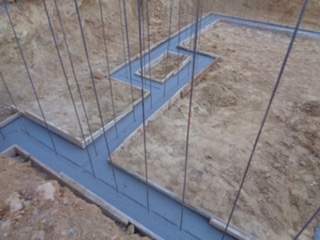
Footing for private residence with vertical wall reinforcement wet set in footing.
Question:
I thought that wet sticking vertical steel as shown in the attached photo has been addressed or is approved by the CFA and/or ACI. Am I correct in this assumption? A private home inspector, hired by the buyers, has referenced ACI and the lack of proven concrete cover at the ends of the vertical steel bards. Asserting that potential corrosion presents a serious concern to the long-term durability of the footing and foundation, he is recommending that the footing should be removed and replaced. What does the code say on this? My client, the concrete contractor, must now defend this practice of wet sticking the vertical steel reinforcing bars. The vertical bars in the photo may or may not have the minimum required 3-in. concrete cover at the bottom end of the bars.
Answer:
The photo presents several conditions addressed by ACI 332-14 and by ACI 332R-063 that are worthy of discussion and to which resolution of this argument can be found. Before addressing that, it should be clarified that ACI 332-14 requires concrete cover over reinforcement of 0.75 in. for any interior exposed element, 1.5 in. when exposed to the exterior and 3 in. for any concrete surface that is in contact with the ground. Reinforcement consists of the horizontal steel prescribed for temperature and shrinkage crack control as well as the vertical steel prescribed when necessary for flexural forces exceeding the concrete’s modulus or rupture. It is first important to understand that ACI 332-14 has permitted driving the vertical dowel connection into the sub grade for pre-positioning the dowels ever since the 2004 edition. The relevant section in 332-14 states:
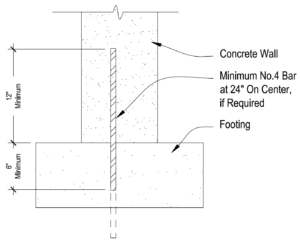
Footing detail showing minimum requirements from ACI 332-14 for lateral connection by dowel.
7.3.4 Wall-to-footing joint—Wall-to-footing connections located in SDC A, B, or C shall be constructed in accordance with 7.3.4.1 or 7.3.4.2. Wall-to-footing connections located in SDC D, E, or F shall be constructed in accordance with 7.3.4.2.
7.3.4.1 A vertical No. 4 dowel shall extend at least 36db into the wall and 6 in. into the footing at a maximum of 24 in. on-center along the footing. To facilitate positioning before concrete placement, vertical dowels are permitted to be driven into the grade in the bottom of the footing.
In this section, 332-14 clearly provides for vertical dowels that do not conform to the requirements of concrete cover. The dowel is not considered reinforcement but rather the positive connection or anchor between the footing and foundation wall. It is for lateral support only. The guide document companion to the code (ACI 332R-06) further explains this condition stating:
3.8.6 – The dowels should extend at least 12 in. (300 mm) above the top of the footing, and 6 in. (150 mm) into the footing. If the depth of the footing is not adequate to develop a straight bar into the footing, the bottom of the dowels can be hooked. Unless prohibited by local code, the dowels may be pushed into the fresh concrete (also referred to as wet setting of dowel) immediately following striking the final level or they may be positioned in the footing form by driving them into the subgrade before concrete placement to maintain their vertical and horizontal positions as well as alignment.
Either concern is covered by these sections of the code. The act of wet setting the steel is not prevented by the code and further examined by the common practices found in the guide. The code only restricts the minimum dimension of the steel connection into the footing (6 in.) and permits the steel extending through the concrete into the grade. Therefore, offering wet setting where confirmation of coverage is not attainable or driving it through the concrete into the grade.
Your photo shows a couple other details that need to be noted. A keyway has clearly been formed into the top of the footing, but the dimensions of this cannot be fully determined for compliance. ACI 332-14 provides for an option to the dowel connection of wall to footing as noted in 7.3.4 with the following:
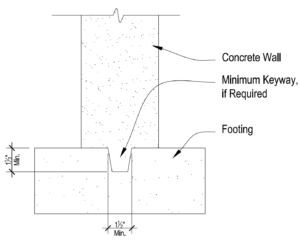
Footing detail showing minimum requirements from ACI 332-14 for lateral connection by keyway.
7.3.4.2 A continuous keyway shall be formed in the footing and shall be located within the middle third of the wall. The keyway specified dimensions shall be at least 1-1/2 in. deep and 1-1/2 in. wide at the top.
7.3.4 directs that either a dowel connection to the footing or a keyway connection is to be used and therefore it is not necessary to have them both. It becomes apparent with both details in your photo, the intent was to use the keyway for lateral stability of the footing/wall joint and the vertical “dowels” are in fact the pre-positioned vertical steel for the wall.
This is where the interpretation of the code should be attended to carefully. While the lack of concern for steel corrosion affecting the long-term behavior of the footing, the fact that the tall vertical bars are likely intended to serve as flexural steel makes them reinforcement and therefore easily interpreted to be required to have cover maintained.
To attend to this in the most effective and efficient manner without the needless waste or resources, time and energy to tear the footing out and start over, it would be proper to cut the vertical bars at 12 in. (or 36db) above the top of the footing. This would make them clearly dowels and an extra detail to the presence of the keyway, or the alternative if there is concern the keyway does not meet the minimum profile noted in 7.3.4.2. The contractor should then proceed by tying vertical bars to the required horizontal steel for support and consistent spacing. These would be disconnected and unrelated to the dowels and therefore not subjected to interpretation of concrete cover related to the bottom of footing.
Want to know more? Contact CFA Executive Director, Jim Baty at 866-232-9255 or by email at jbaty@cfawalls.org. The Concrete Foundations Association mission is to support the cast-in-place contractor as the voice and recognized authority for the residential concrete industry. ACI documents can be obtained by contacting the CFA or by visiting the American Concrete Institute (www.concrete.org) and ordering from their bookstore.
References:
- 2015 International Residential Code® For One- and Two-Family Dwellings published by the International Code Council, Inc., 4051 West Flossmoor Road, Country Club Hills, IL 60478-5795 | Phone 1-888-422-7233 | www.iccsafe.org
- Residential Code Requirements for Structural Concrete (ACI 332-14) and Commentary published by the American Concrete Institute, 38800 Country Club Drive, Farmington Hills, MI 48331 | Phone: 248-848-3700 | www.concrete.org
- Guide to Residential Concrete (ACI 332R-06) published by the American Concrete Institute, 38800 Country Club Drive, Farmington Hills, MI 48331 | Phone: 248-848-3700 | www.concrete.org
Opiates and Workers’ Compensation Injuries: Dangers and Solutions
In combating the epidemic of addiction, the U.S. Surgeon General has just announced plans to tackle alcohol and drug abuse, nationally—especially opioid addiction—urging doctors, policymakers and the public to ramp up efforts to combat the growing U.S. healthcare crisis.
The numbers are real! Since 2000, the rate of overdose deaths involving opioids—Fentanyl, Percocet, Vicodin, and others—has increased by 200 percent, according to the Centers for Disease Control and Prevention (CDC). And, in 2014 alone, nearly 30,000 people died from a drug overdose involving some type of opioid, including prescription pain relievers and heroin—more than in any previous year on record. Per recent prescribing guidelines issued by the CDC, doctors must change how often and to whom they prescribe drugs like OxyContin, Percocet or Vicodin. No longer can doctors assume that people who are in legitimate pain are not at risk for Opioid addiction, as was standard medical practice for decades, the report notes. What’s important is that the CDC’s analysis shows that the longer a person takes Opioids, especially at the higher doses, the greater the risk for serious effects, including addiction, overdose, and death. The statistics apply for all use the drugs – even those legitimately prescribed to combat pain. While most people taking Opioids don’t become addicted, nearly everyone who takes the drugs longer than a couple of weeks or so becomes dependent on them.
Prescription Opioids are presently the number one workers’ compensation cost driver (in dollars) that controls the ultimate price of medical and indemnity losses. In addition to the escalating expense involved in opioid prescription, use and abuse, is the addiction to these drugs. The situation is dangerous to employees and employers, and in some cases, fatal.
Never has there been a more destructive influence on the cost of workers’ compensation claims from a single source than the abuse of opioid prescriptions for the management of chronic pain. Nationally, an estimated 55 to 86 percent of all injured workers are receiving Opioids for chronic pain relief. According to the NCCI, the costs for prescription narcotics per claim are rising in the U.S. In fact, medical costs are now approximately 59 to 60 percent of the total cost of workers’ compensation claims. Of those medical costs, narcotic drugs account for approximately 25 percent. Significantly, the construction industry has seen the greatest increase in workers’ compensation claims resulting from narcotic painkiller addiction; thus, a leader in managing the higher expense of drug use and abuse.
Workers’ compensation claims data shows that adding extended Opioid use will more than likely triple to quadruple the cost of a single claim. What key factors cause Opioid use to significantly increase the medical and indemnification costs?
- Employees are less likely to return to work
- Increased doctor visits
- Less focus on recovery and more focus on gathering drugs
- Additional medical testing
- The likelihood of a claim ending up in litigation is 75% when Opioid use is longer than 14 days.
When you combine the over-prescription of Opioids with the common diagnoses of pre-work injury depression or anxiety disorders in individuals, you can easily see the connection to a bigger problem. The combination is becoming toxic and is taking hold of real people….when serious work injuries occur…people can take a wrong turn in over-use of Opioids and become hooked.
Drug addiction is not pretty nor does it have a pretty face. In reality, Opioid addiction in the workers’ compensation arena touches all injured employees regardless of their propensity for drug abuse. It reaches all people regardless of your income status, overall good healthy, and regular medical visits aside from work injury treatment. Frankly, the average worker has never had a major injury and has never been prescribed narcotics, so they do not understand the impact these strong, mind alternating prescriptions can have on them emotionally. But, the adverse impact is possible with every injury and every employee.
Opioids impact the receptors in the brain and cause a euphoria or high. All Opiates are rather effective anxiolytics (anti-anxiety) that have traditionally been used with positive results as anti-depressants. The positive affects of Opiates start when they initiate the release of a cascade of dopamine in the brain, which creates feelings of pleasure and reinforces the behavior, i.e., ingestion of the substance. Because of the intense high produced by the interaction of several opiates and the brain, the drug, once ingested, remains extremely addictive, sometimes causing measurable symptoms of addiction in fewer than three days.
Although Opioids have been used with positive results, studies show that construction workers, for example, have a higher rate of undiagnosed depression than U.S. workers in other fields. The most common diagnoses are depression, panic disorder and generalized anxiety, but the range covered personality disorders, eating disorders, suicide risk and substance abuse as well as mood disorders. This high occurrence suggests a lack of social support and coping strategies when it comes to dealing with substantial mental distress. Possible reasons for this lack of help-seeking behavior could involve reputational concerns and the fear of losing their job.
When you combine the over-prescription of Opioids with the common diagnoses of pre-work injury depression or anxiety disorders in individuals, you can easily see the connection to a bigger problem. The combination is becoming toxic and is taking hold of real people. Research tells us that those whose lives are taken over by drug addiction are often from stable homes with strong families. But, when serious work injuries occur, these regular people can take a wrong turn in over-use of Opioids and become hooked. And once you’re hooked, it is so very hard to get away from these drugs. The adverse effect begins with the individual, extends to that person’s family and friends, and then spirals down to impact the employer and its business.
Unfortunately, doctors have historically prescribed Opioids far more broadly than is medically advisable, often as a method of managing chronic pain. Several states require that doctors check an electronic prescription database to see whether patients are receiving Opioid painkiller prescriptions from other doctors before writing a prescription for the drugs. It’s crucial that doctors think carefully about whether to prescribe an opioid painkiller in the first place — and that patient’s think carefully about whether to begin treatment with those drugs, especially if they have a history of addiction and depression.
As employers, the best strategy is to be armed with valuable information about the dangers of Opioid use to better manage claims. Positive intervention that focuses energy on high-risk claim situations before serious problems develop can yield the best results. Some of these interventions include: proactively meeting with injured employees to discuss return-to-work strategies, Opioid education seminars with both employees and prescribing physicians, and partnering with local doctors who can educate your employees on managing pain and deliberate avoidance of physicians who prescribe and distribute opioids themselves versus of those who partner with pharmacies.
Thinking Ahead
The human and monetary costs associated with Opioid use by employees are clear but can be potentially offset by implementation of substance abuse programs for employees, including education, employee assistance program (EAP) services, and access to confidential treatment. The National Safety Council (2014) recommends that companies consider taking the following actions:
- Establish a drug-free work environment enforced by random drug testing. Managers should develop rules with legal counsel and human resources to ensure inclusion of risk management, injury protection, and liability information. Terms should be clearly articulated and distributed in writing to all employees. In developing the company’s drug use policy, employers also may want to include a medical review officer to evaluate the policy and results from testing.
- Managers need to familiarize themselves with the company’s drug policies pertaining to prescription medication use, as well as regulations on fitness for duty and return to work. For instance, appropriate use of certain prescribed medications may be covered by the American Disabilities Act and, therefore, may not be subject to violation of drug testing.
- Training for supervisors should provide education on how to identify Opioid use disorder behaviors. Similarly, understanding strategies on how to effectively intervene and communicate with employees who may be struggling increases the likelihood of individuals receiving treatment in a timely manner.
- Employee wellness programs can provide valuable education about the risks associated with Opioid use, including impairments in driving, concentration, strength, coordination, balance, and judgment. Individuals taking Opioids also should be reminded about contraindications with alcohol or other medications, such as antidepressants, sedatives, or other psychoactive drugs, which can further impair their cognition and functioning.
- An EAP is a vital resource for directing employees to confidential treatment as needed, including inpatient detoxification, medication-assisted therapy (e.g., buprenorphine, naltrexone), and psychotherapy. Screening, treatment, and aftercare should be benefits covered by the company’s health plan. Employer- sponsored interventions can help defray costs associated with having to replace an employee altogether, such as loss of continuity and productivity.
- Prescription benefit manager technology can be used to alert physicians to potential misuse or abuse. For example, such as attempted early refills, the prescription of opioids with other medications that may be contraindicated, and visits to multiple physicians for the same prescription—known as “doctor shopping.”
- Informing employees about their rights and treatment options creates an environment more conducive to help seeking. Employees who want help may understandably worry about whether they will lose their job while in treatment. The Americans with Disabilities Act offers some protection, as does the Family Medical Leave Act. What constitutes a “typical” treatment plan varies by an individual’s diagnosis, severity, and level of functioning. Offering short-term and long-term disability allows employees to continue collecting an income if they need to enter rehabilitation, which will require them to take time off from work.
- Finally, employers can help mitigate stigma associated with substance use disorders by educating employees about the biological nature of addictions. Substance use disorders are brain-based illnesses; they are not diseases of failed willpower or character weakness. Creating a tolerant, understanding work environment helps increase the likelihood that employees will feel comfortable seeking assistance.

ABOUT THE AUTHOR
Kristen Long is Managing Director of the Midwest Region – Construction Practice for Arthur J. Gallagher of Chicago, www.ajgrms.com. A.J. Gallagher is the broker for CFA Core360, the CFA’s member-only insurance program for complete and individualized business insurance lines specific to the cast-in-place concrete industry. You can reach Kristin at Kristen_Long@ajg.com.
Trick of the Trade Corner: Labor Savings & Quality Improvement
This issue’s Trick of the Trade is shared by Andy Stachler of Stachler Concrete Inc. in St. Henry, Ohio. Andy responded to last quarter’s column featuring the inside corner stripping tool offered by Dennis Purinton and answering the challenge by our President. Andy’s tip has rewarded his member account with 50 points he can redeem in an upcoming registration, event or purchase.
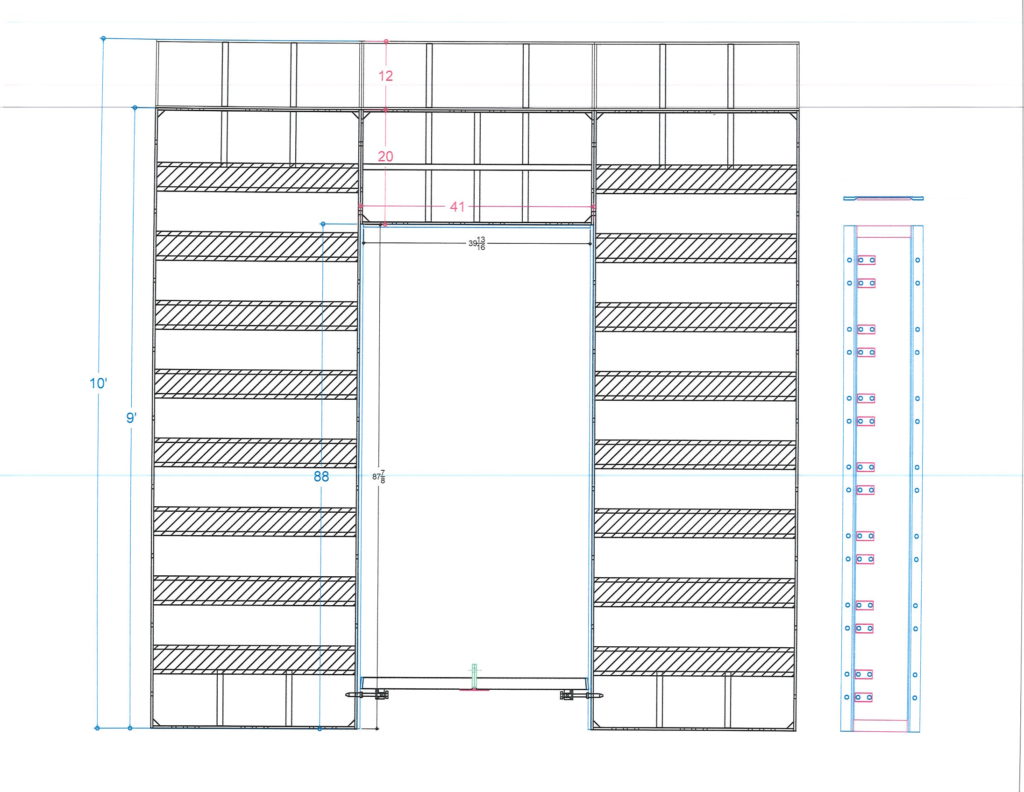
The door block-off forms designed by Stachler Concrete, Carroll Construction Supply Inc. and Wall-Ties & Forms. ANDY STACHLER challenges you to think of one of your time-savers and submit it to the CFA.
One of the biggest labor savers and quality improvement we have made on our projects is the addition of a custom form for blocking out the doorways in basements. Whether an interior or exterior doorway, the forming necessary to create these otherwise simple openings was extremely time-consuming and always challenged our quality control to maintain squareness both during forming and concrete placement.

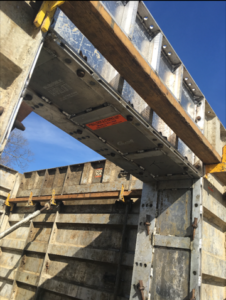 Working with our branch of Carroll Construction Supply and forming system manufacturer, Wall-Ties and Forms, Inc., we asked the question of the most effective way to form this with modifications to our system without the addition of lumber. Their solution was a simple custom forming product that added easily to our existing forms. This has resulted in considerable savings of both time and money on our projects with the repetitive use. It has also greatly improved our tolerances on doorway forming, resulting in tighter fits for our customers and much cleaner finished openings. We not only discovered an effective and easy custom form product that was added to our inventory, we tested and confirmed the value of working with our regional product specialists and national equipment manufacturers during the process of creating solutions. They know their products far better than we do.
Working with our branch of Carroll Construction Supply and forming system manufacturer, Wall-Ties and Forms, Inc., we asked the question of the most effective way to form this with modifications to our system without the addition of lumber. Their solution was a simple custom forming product that added easily to our existing forms. This has resulted in considerable savings of both time and money on our projects with the repetitive use. It has also greatly improved our tolerances on doorway forming, resulting in tighter fits for our customers and much cleaner finished openings. We not only discovered an effective and easy custom form product that was added to our inventory, we tested and confirmed the value of working with our regional product specialists and national equipment manufacturers during the process of creating solutions. They know their products far better than we do.
Marijuana At Work
On November 8, four states approved the use of recreational marijuana bringing the total to eight states and the District of Columbia. Alaska, Colorado, Oregon, Washington, and the District of Columbia had already approved recreational use. California, Maine, Massachusetts, and Nevada joined the recreation use states on November 8. In addition, Arkansas, Florida, and North Dakota passed medical marijuana laws, bringing the total to 29 states, Puerto Rico, and the District of Columbia. Concrete contractors are legitimately concerned about workers who are high on the job.
Marijuana remains a Schedule 1 drug, which means it is illegal and has no known medical use – at least according to the federal government. Thus, it is not lawful for a worker to use pot at work or be impaired by it. Employers with workers subject to the DOT’s regulations must maintain a zero-tolerance drug policy, at least with respect to those workers. Generally, this includes anyone who drives a truck as part of their job. In addition, contractors with federal grants or contracts must adopt a zero-tolerance policy to comply with the Drug Free Workplace Act.
Cannabis is often used for its mental and physical effects, such as a “high” or “stoned” feeling, a general change in perception, euphoria (heightened mood), and an increase in appetite. Long term side effects may include addiction, decreased mental ability in those who started as teenagers, and behavioral problems in children whose mothers used cannabis during pregnancy.
Some immediate undesired side effects include a decrease in short-term memory, dry mouth, impaired motor skills and reddening of the eyes. Aside from a subjective change in perception and mood, the most common short-term physical and neurological effects include increased heart rate, increased appetite and consumption of food, lowered blood pressure, impairment of short-term and working memory, psychomotor coordination, and concentration. Some users may experience an episode of acute psychosis, which usually abates after 6 hours.
Decriminalization-only statutes have been enacted in Alaska, California, Colorado, Georgia, Hawaii, Maryland, Massachusetts, Michigan, Montana, New Jersey, New Mexico, Oregon, Vermont and Washington. These states’ laws are silent on employment issues, and courts in California, Colorado, Michigan, Montana, Oregon and Washington (including the Supreme Courts of California, Montana, Oregon and Washington) have ruled that employers may take adverse action following a positive drug test result because decriminalization statutes are not intended to address employment.
The following states — Arizona, Connecticut, Delaware, the District of Columbia, Illinois, Maine, Minnesota, Nevada, New Hampshire, New York, and Rhode Island — have laws that, in addition to decriminalization, address employment (e.g., limiting adverse action and/or requiring accommodation). These laws conflict with the current federal law.
In the US, men are over twice as likely to use marijuana as women and 18-29 year-olds are six times more likely to use as over 65-year-olds. In 2015, a record 44% of the US population has tried marijuana in their lifetime, an increase from 38% in 2013 and 33% in 1985. This makes usage a genuine concern for concrete contractors.

As marijuana is legalized, usage increases. For example, after marijuana was decriminalized in Colorado, the number of positive workplace drug tests increased by 20 percent between 2012 and 2013, compared to a national average increase of five percent.
Pursuant to the Occupational Safety and Health Act, all employers have a general duty to maintain a safe workplace. This cannot be done if employees are permitted to work while impaired by alcohol or marijuana (or other substances). Although the Americans with Disabilities Act requires an employer to reasonably accommodate a physical or mental impairment that substantially limits a major life activity, the ADA does not protect users of illegal drugs. Moreover, if the position involved is classified as “safety-sensitive,” employers may be able to assert that there is no accommodation that would not lead to undue harm, as marijuana use by the employee or applicant “may pose a ‘direct threat’ to the health and safety of himself” or another.
One problem that contractors may face stems from the nature of drug testing. Urine testing only detects the presence of metabolites which can stay in the system for days after use. Unfortunately, this means that urine testing does not detect impairment. In states where the law requires accommodation or protects workers who use pot, proof of impairment is essential if the worker is to be disciplined or terminated. If you suspect that an employee was impaired by marijuana at the time of a work-related injury, do not rely on a urine toxicology test alone, but seek other evidence to show impairment, such as surveillance cameras and the statements of other employees.
A well drafted drug testing policy is essential for concrete contractors. A god policy must prohibit impairment, not just possession or use. Ideally, the policy should prohibit the presence of THC or marijuana metabolites in the worker’s system. The policy should define as illegal those substances prohibited by state or federal law. And the policy should explicitly state that all applicants will be tested before commencing work. Consider also testing post-accident, return from leave, reasonable cause, and also random testing.
In those states where the law imposes a reasonable accommodation duty, use the same process as you would under the ADA. After a positive drug test, ask if marijuana use is for medical purposes, but do not ask about the underlying condition or impairment. Next you will want to explore whether any other reasonable accommodation – other than marijuana – is possible. Finally, you will make the undue hardship determination. Remember, if the job is “safety sensitive” it will almost always be an undue hardship to let the worker use pot.
Concrete contractors must remain vigilant in this area. Know the law in your state and your obligations and rights. Always use a well drafted drug testing policy. And make certain that your employees know your policy and its consequences. Here, use of an acknowledgement form is wise.

ABOUT THE AUTHOR
David C. Whitlock has been a lawyer for over 25 years. He specializes in Labor and Employment Law representing companies as they deal with complex federal, state, and local laws, regulations, and ordinances. If you have an employment-related compliance question, he can help you. David also spends a large amount of time helping companies employ foreign workers under the US immigration system. Business immigration is a complex and technical law practice, but David has excelled at it for over 25 years. Contact David Whitlock at 404-626-7011 (phone), davidcwhitlock@gmail.com (email) or visit his website, www.davidcwhitlock.com. David can also be met easily at CFA Convention each summer.
Impressed To Success

Dennis Purinton, Purinton Builders, Inc. – CFA President 2016-18, purintonbuilders@yahoo.com
Many years ago, a customer made the comment that he only wanted to do business with successful people. He explained, part of being successful is acting successful and dealing with successful people.
The mission of this Association for the past forty years has been to promote and help Concrete Contractors along the path to success. Success for each is certainly individual and might mean growth, profitability, customer satisfaction, employee appreciation and much more.
The summer meeting in Myrtle Beach this past July, was a gathering of companies helping each other by sharing the events of the year, as well as their knowledge.
What intrigues me so much with this event is how easily this is shared towards the goal of success for all. There were twenty-six exhibitors displaying inside and several brought equipment that was displayed outside. The representatives from these companies presented their products/equipment with great information on how each might be used to increase production, quality and profitability. Also, explained by many of these representatives were the essential safety features, best safety practices and ways to effectively market their products. I know you can get at this elsewhere but nowhere else am I able to spend as much time discovering and developing a deeper understanding or identifying a new possibility than with the dedicated two days I had with these reps.
Convention was about a whole lot more than just an equipment show, though. We had thirteen speakers on ten different topics in the education program. The topics represented many aspects of our industry and were presented by attorneys, insurance professionals, technical specialists and several of our own Contractor Members.
Added to this atmosphere of learning found in the formal presentations were several hours of dedicated networking. Whether it was over coffee, one of the many meals, in the hallway at break or even a few beers at the end of the day, sharing the ritual and pressures of the job or the challenge of the latest concrete “placement” was more than just icing on the cake. Our members understand that loyalty and communication to each other is key to all our successes. Personally, our company has purchased products or services from thirteen of the exhibitors or speakers and I am sure we are not alone.
The next “big” event is the World of Concrete in Las Vegas. Please go to the CFA website and register for the WOC through our site. Please stop by our booth to chat and make plans to attend the Tuesday night dinner at Hofbrauhaus. We would love to share all that we can offer with you.
Over the past months I have already had the pleasure of talking to several our members in a new way as President of this Association. I want to hear from all of you and see you become an active part of the CFA success story.
What’s In Your Wallet?

James Baty, CFA Executive Director, jbaty@cfawalls.org
Another round of Capital One commercials are streaming across every form of my media these days. While I enjoy seeing the newest way to get (or prevent) a point across, it did give me a reason this week to pause and contemplate what it means for our industry. Seriously, what’s in your wallet (if I can borrow the line from Capital One)?
In my conversations around the industry, there is a whole lot in the wallets of concrete contractors these days as compared to years in the past. If you’re invested in the stock market, there should be even more in your portfolio, as the latest wave of confidence in our economy is trending toward daily and weekly records. Yet, for most of the construction world there is still a pervasiveness of conservatism, perhaps even disbelief. It is as if we are all just waiting…and waiting…and still waiting for the “what comes next.”
We’re about moving forward in this Association, with an incredibly diverse and strong membership leadership committed to dreaming and working for this industry’s future…your future. What I see from them more than anything else right now is that we are no longer just waiting for you, that is for the hundreds of companies in this industry that fit the profile of a member. I’m very pleased at this new direction from casting a net over ways for this industry to excel through the minds of company managers that recognize that now is the time for change to be made, not accepted.
This issue offers another layer of thoughts on the increasingly complicated topic of managing a workforce. You’ll find tones of this in articles on the latest risks associated with medicines and substance abuse as well as returning employees to work.
While the last decade has taught the concrete contractor to be content, thrifty and resourceful in managing equipment and product needs, now is the exact time to be practicing the art of expanding the mind and reaching out to ideas that challenge new processes, new solutions and new offerings. We have added a reader service card and information to each ad making it possible for you to more effectively connecting your areas of possible interest to the best information resources to bring them to you.
Change also comes in stepping forward into a new opportunistic future. You can survive but can you thrive? This is the question that is now before you. I see some great companies taking control of their future, investing in new risk management, new peer networking and not just broadening their access to information but challenging the very foundations of their knowledge base to be better prepared for tomorrow’s consumers. You need to invest time, energy and wisely aligned monies to pace ahead of the risks. Is this the challenge you’ve been waiting for?
Association Board Adds New Leader
Beginning a new, three-year term on the CFA Board of Directors is Chris Ward, Vice President for the Americas with Western Forms of Kansas City, Missouri.
Each year during the Annual Meeting for the Concrete Foundations Association, held in conjunction with the summer’s big event, transition takes place as Board members end their time in leadership and new members step forward to take up the reins. This year, one Board seat saw such a transition as the Board and CFA members saluted and gave appreciation for the service of Tom Oury from Schwing America. Tom was elected to service by the National Associate members who manage three seats on the Board of Directors. Beginning a new, three-year term as elected by the same body of members is Chris Ward, Vice President for the Americas with Western Forms of Kansas City, Missouri. I had a great chance to sit down with Chris during the event and pick his brain about the CFA and this industry, to help introduce the newest leader to each of you but also to help me get to know another side of this industry.
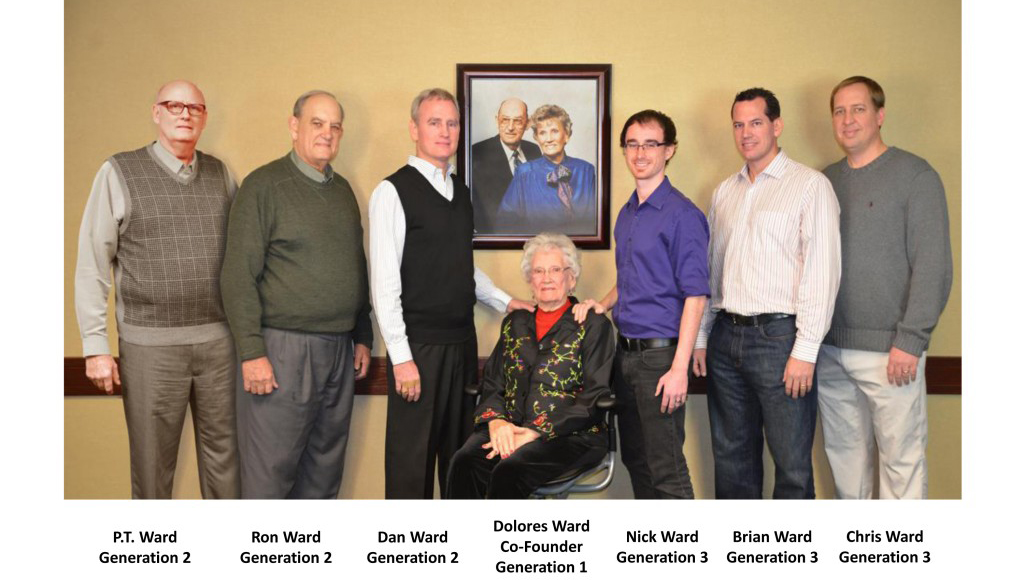
The Ward Family of Western Forms, Inc.
Lindsey: Chris, I understand from our staff that the Ward name has a lot of history in leadership with the Concrete Foundations Association. What is your earliest memory of the Association?
Chris: Well, yes, certainly Western Forms and my dad, Ron Ward has a lot of history with the CFA. Personally, I don’t have many memories of early days going to CFA as a family or as kids. My first memory was in Breckenridge and I was like 18yrs old. Without giving a lot of detail that is best left in Breckenridge, I was invited out with Greg Peacock, a former contractor member, Board member and an inventor that brought about the BEP Forming line; and a bunch of other folks. There were bars in downtown Breckenridge and Peacock was, well…I’ll tell you the rest off-record.

Chris Ward and his kids celebrating the KC Royals. L-R: Ben (1.5), Chris, Annie (9), Wyatt (5) and Jake (7).
Lindsey: To funny, that is certainly good to know. Legacy is something well respected in both this industry and in the Association, whether you are talking with a CFA member or many of the companies throughout North America that are likely reading this interview. What does the word legacy mean to you when you think of Western Forms and the CFA combined?
Chris: When I think of legacy and what that means for Western Form Inc. and the CFA, I think about the early days when parts of the country were converting from block foundations to cast-in-place walls. I think of my grandfather and Ron Ward, my father, who helped play a role in this shift and in developing different markets. The CFA was a good chance for this group to get together and collaborate with one another on best practices.
Lindsey: I can see those best practices being shared still today in the events we host and can just imagine how important they were when an industry was getting started. So now you get to be part of the mechanics that make these events and this type of network happen. What is your biggest interest in serving as a CFA Board member?
Chris: The biggest interest I have in serving as a Board member is to play a role in working closer with some of the members to further grow and improve the cast-in-place industry heading into the future. It is not so much converting block markets anymore but it is trying to determine upcoming opportunities and best practice to continue to advance the industry.
Lindsey: So a combination of innovation and evolution of best practice and technology. I certainly see that at play. What statement would you make to contractors around the country about the CFA now that you have the voice of a Board member?
Chris: I would say “find a way for more collaboration”…sharing of best practices and new initiatives for now and the future is the key to growth. This is not only for the Association but for all of our individual business, some of which have a lot of history and may not easily see the opportunity.
Lindsey: It is electric when you see members connecting in this way at our summer event or during the Winter Meeting in Vegas. So tell me, what is a little known fact about Chris Ward that you can share? How can we get to know you as a personality on the Board?
Chris: I had the opportunity/curse to be the “oil dog” for two summers back in the day working on a wall crew here in Kansas City back in the 1993-95 time frame. I had to go on the D.L. for two to three weeks when I fell off a 9-ft wall, landing on a footing with my kneecap. Fun times. If you want some “stats” on me, I’d have to offer that I have been married for 12 yrs. to my beautiful wife Katie. We have four kids Annie (9), Jake (7), Wyatt (5), Ben(1.5). I have been working with Western Forms for 16+ yrs. where I have had roles including work in the warehouse, customer service, sales, and currently in the role of V.P. of Americas. I enjoy spending time with my kids and their various activities; enjoy playing basketball, golf, and of course cheering on my World Champion Kansas City Royals.
Lindsey: Well, I see you and our Executive Director, James Baty share that passion for the Royals and family, as well I’m sure our other members in the Kansas City area. What names come to your mind when you think of those that have impacted this business, this Association?
Chris: The first name that comes to my mind is Bill Esker & the Esker. Bill was instrumental within the organization early on, assisting with growth as new contractors were reached. Also, he was a proponent for evolving the business, being the first or one of the first to utilize boom trucks and that technology. Now, it is the standard for most, yet was a huge leap forward in the industry.
Lindsey: That’s super. I know Josh serves on the Board today so there is more support for our discussion of legacy. I’d like to wrap up with you and ask your opinion of what you see as the single largest risk and single biggest opportunity to the cast-in-place concrete industry?
Chris: Labor is the biggest threat to the cast-in-place market. It is going to continue to get worse for the entire construction industry. I see this as a problem, but it is also a huge opportunity for those companies that look at doing things differently and understanding that the way things have always will be done…will not cut it moving forward.
Lindsey: Chris, thanks for taking this time with us and sharing some intimate details as well as some insight that you bring in to your new role as a leader of this industry on the Board of Directors for the CFA. Welcome to this effort and best wishes for the time you will spend on behalf of all these readers, members and non-members alike, over the next three years.
Chris Ward becomes the fifth direct elected director to the CFA Board following a transition of the National Associates council and Association by-laws in 2010. He joins Lindsay Castles of GMX, Inc. and Mark Irving of Irving Equipment, LLC. serving the interests of the many products, technologies and equipment that are found in membership. Contractor and professional members to the Board of Directors are elected at large each Spring based on the number of seats that become available. To find out more about participating at the Board level, contact CFA Executive Director, James Baty at jbaty@cfawalls.org.
Want to know more about Western Forms, Inc.? Visit their website at www.westernforms.com or contact Chris Ward directly at cward@westernforms.com.

ABOUT THE AUTHOR
Lindsey Bloomquist, Manager for Communication and networking for the Concrete Foundations Association (CFA), works to communicate the available tools and benefits of a CFA membership to the industry, and provide networking opportunities that build professional relationships between contractors and industry leading suppliers and manufacturers. Bloomquist also works closely with industry suppliers and manufacturers to increase exposure within the CFA through advertising, sponsorships, exhibits and networking. Reach Lindsey at lbloomquist@cfawalls.org.
“The professional relationships that are established are vital to the success of this association and its member companies. Not only do these interactions foster healthy competition that fuels innovation, but they create lasting partnerships that are beneficial to both the contractors and suppliers.”

